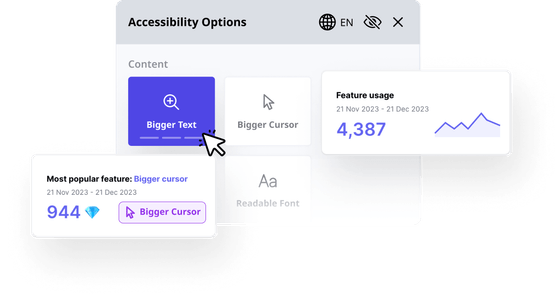The Americans with Disabilities Act (ADA) plays a significant role in websites and online content for individuals with disabilities. In California, specific web accessibility standards have been adopted for businesses to promote digital inclusivity.
Keep reading to learn more about ADA compliance in California, why it’s important ,what website accessibility entails, and some words on supporting regulations such as the Unruh Civil Rights Act and California Assembly Bill 434 (AB 434). These regulations aim to prevent discrimination and bridge the accessibility gap for individuals with disabilities in accessing digital resources.

What is ADA website compliance?
ADA website compliance in California aligns with the Americans with Disabilities Act (ADA), ensuring enhanced accessibility for individuals with disabilities when navigating websites and online tools.
Proper website accessibility incorporates visual, auditory, and cognitive design elements to make it easier for individuals with disabilities to consume content. These features include but are not limited to, alternative text for images, compatibility with screen reader software, improved keyboard navigation options, closed captioning, and simplified layouts tailored for individuals with cognitive disabilities.
Here is a quick ADA compliance checklist web developers can use as a reference, that contains many of the web content accessibility guidelines discussed in this guide.
Why is ADA website compliance important in California?
There are several reasons why California accessibility laws exist, including, but not limited to, the following:
Legal Requirement
As per the California Civil Code and Unruh Civil Rights Act, businesses are mandated to make a concerted effort to provide equal access to individuals with disabilities by making websites and public accommodations accessible.
Violating either legislation can result in serious consequences like legal action, financial penalties, and reputational damage that can take months if not years to fix. Plaintiffs have the world at their disposal when it comes to relief options, with the potential to sue for damages, lawyer fees, and dozens of other penalties.
Risk Mitigation
Meeting ADA compliance avoids legal fees, lawsuits, negative publicity, damage to brand reputation, and fosters inclusivity and equal access. Furthermore, it is often a prerequisite for accessing government contracts, offering a significant financial incentive.
Strategic Decision
Following web accessibility standards naturally helps with increased traffic, potential SEO boosts, and higher revenue. With roughly 15% of the country partially or fully disabled, addressing the needs of individuals with disabilities makes a big difference to the bottom line.
Understanding Additional Accessibility Requirements and Regulations in California
To understand website accessibility requirements and the ADA’s role in California, two important pieces of legislation to know are the Unruh Civil Rights Act and California Assembly Bill 434 (AB 434).
Unruh Civil Rights Act
The Unruh Civil Rights Act, a pivotal piece of California legislation preventing discrimination in public accommodations, was established in 1959 and named after Jesse M. Unruh, former speaker of the California State Assembly. This law prohibits discrimination based on protected characteristics, including race, color, physical abilities, gender, national origin, disability, and others. At first applying to brick-and-mortar locations, the act now includes digital domains.
Businesses failing to adhere to the Unruh Civil Rights Act face severe legal consequences, including possible civil rights violation lawsuits, monetary damages, and other remedial actions brought by the California Department of Fair Employment and Housing. As of this writing, protected characteristics include race, color, religion, ancestry, sex, sexual orientation, gender identity, age, disability, marital status, medical, and genetic information.
As with most laws, exemptions may apply. For example, churches and specific housing (e.g., low-income housing) are typically excluded from its provisions thanks to the audiences they serve.

California Assembly Bill 434 (AB 434)
The California Assembly Bill (AB 434) oversees the Broadband Access and Adoption Task Force, advocating for individuals with disabilities by providing recommendations to the state government to promote accessible broadband access in underserved communities. This includes making policy recommendations, informing legislation, launching accessibility tools, and conducting educational initiatives to raise awareness about ADA compliance for all businesses, including small businesses.
In addition to serving underserved communities, AB 434 promotes digital accessibility and inclusive design principles across digital services, raising awareness and educating businesses and organizations on ADA standards and their application, as well as how to avoid accessibility lawsuits.
In summary, the bill focuses on expanding infrastructure and ensuring equal access to broadband services for all California disabled persons per state laws and federal laws, regardless of their location or background.
Differences Between Unruh Civil Rights Act and AB 434
The primary distinctions between the Unruh Civil Rights Act and AB 434 lie in their scope of coverage and enforcement methods.
Firstly, the Unruh Act is a California state law designed to prevent discrimination against individuals with disabilities across various public accommodations, including theaters and retail stores, with a focus on digital. Conversely, the ADA is a federal law, encompassing broader domains such as employment and telecommunications nationwide.
Secondly, the Unruh Act can involve civil website accessibility lawsuits initiated by individuals with disabilities against businesses and organizations that violate the Act. These individuals may work alongside the California Department of Fair Employment and Housing (DFEH) to address discrimination. If any lawsuit results in penalties and damages, plaintiff damages may rise several times over the incident’s value, along with a minimum statutory damage amount of $4,000. Additional compensation may be offered for emotional distress.
In contrast, ADA enforcement is overseen by federal agencies like the Department of Justice from the federal government. Enforcement options include filing civil lawsuits (under Title III of the ADA) and negotiating private settlements with the Department of Justice. These settlements typically involve business establishments and organizations making concessions to achieve ADA compliance.
In summary, while the Unruh Civil Rights Act and AB 434 share similarities, such as their aim to prevent discrimination, they differ in terms of coverage and enforcement mechanisms.
A Word on Accessibly
Common accessibility issues on websites and platforms not meeting the ADA’s general requirements include complex navigation and other website accessibility issues, such as inaccessible forms, incomplete captions, and poor color contrast selections, all of which pose challenges for individuals with disabilities.
One effective approach to addressing website accessibility compliance in California is with an increased ADA-compliance widget. Accessibly is compatible with most websites, mobile apps, and platforms, enriching individuals with disabilities with full and equal enjoyment of ADA-friendly features such as enhanced reading lines, large cursors, adjusted colors, text-to-voice functionality, and more. Plus, no web developers/website developers are needed – anyone can install the widget making websites accessible for all.
Supported platforms include Squarespace, Weebly, Elementor, WooCommerce, and Webflow.
If you want to achieve ADA compliance in California to maintain California accessibility standards such as WCAG 2.1 level AA, Accessibly is your tool! Even a single lawsuit due to not abiding by the ADA’s Section 508 can turn your business prospects around for the worse, leading to numerous legal ramifications like ADA lawsuits. Therefore, investing in accessibility widgets like Accessibly is important to minimize risks and allow equal access of websites and mobile apps to individuals with disabilities.

Steps to Achieve ADA Compliance
In order to achieve ADA compliance, there are several steps you should take.
Learn ADA/WCAG
First, immerse yourself with the Americans with Disabilities Act (ADA) and the Web Content Accessibility Guidelines (WCAG), studying every page if you have time. The ADA is a comprehensive civil rights law aimed at prohibiting discrimination against individuals with disabilities, while WCAG is a series of best practices authored by the World Wide Web Consortium (W3C) to make websites and digital platforms more accessible to individuals with disabilities on the basis of four principles: Perceivable, Operable, Understandable, and Robust.
Audit Your Website
If your website has accessibility issues, now may be an excellent time for an accessibility audit. The popular Axe and WAVE combo is one way to go about it, which is favored by both regular users and website developers for its quick scanning ability that identifies problematic issues such as poor navigation, missing alternative text, inaccessible forms, improper HTML markup, and a lack of content structure, making it difficult for individuals with disabilities to find the information they need.
Execute!
Once you have familiarized yourself with ADA/WCAG guidelines and performed a complete website audit, it’s time to execute! One of our preferred methods is using Accessibly, one of the web’s leading ADA/WCAG compliance widgets that allows you to update existing websites with the latest in accessibility features, from larger cursors to alternative text for images for the visually impaired. Always stay on top of ADA web accessibility standards, ensuring full and fair participation for all individuals with disabilities.





